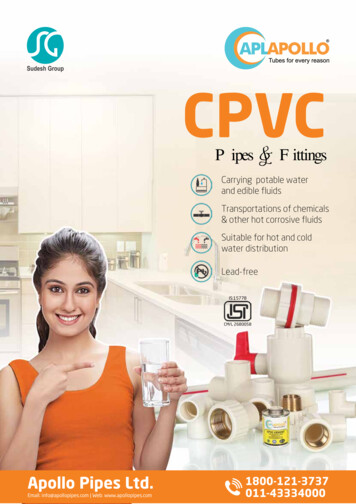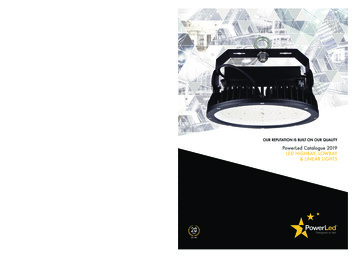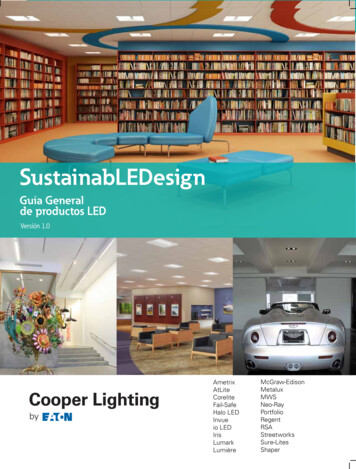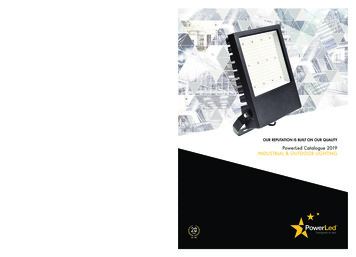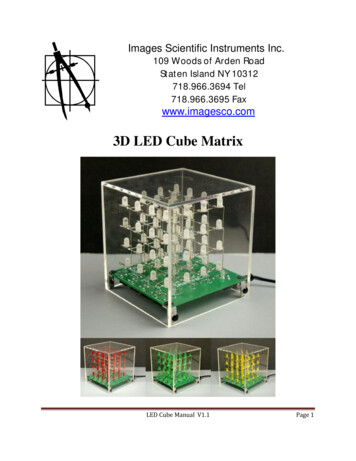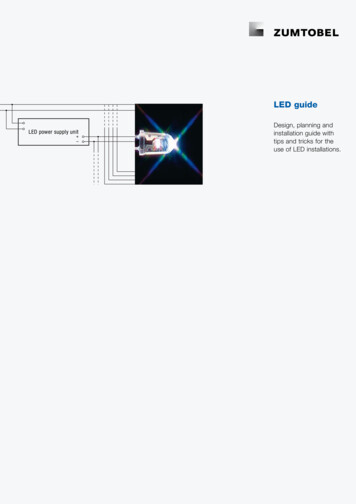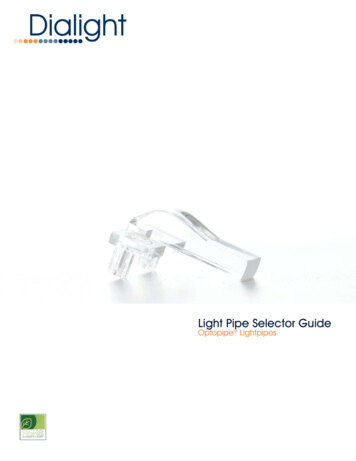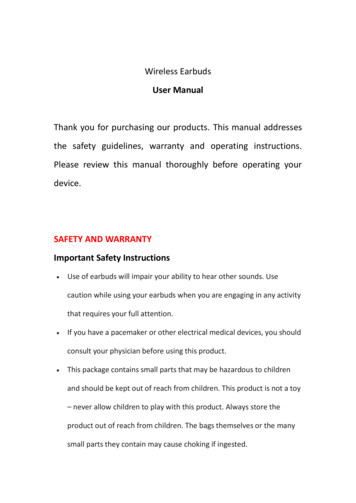
Transcription
DESIGNING AND OPTIMIZINGLIGHTGUIDES/PIPES – TIPS & TRICKS FOR ASTREAMLINED PROCESSPresented by :Lambda Research Corporation25 Porter Rd.Littleton, MA 01460www.lambdares.comConfidential & Proprietary ‒ Lambda Research Corporation
Agenda Setting Specifications for Light Guide/Pipe Design Design Constraints Principles Basics Design Tips Design Basics Example 1 Example 2 ConclusionsConfidential & Proprietary ‒ Lambda Research Corporation
Setting Specifications forLight Guide/Pipe DesignBe careful when selecting your source.Do you have enough LED power to achieve your goal?Set an output specification with the following in mind: Illuminance Efficiency Angular Output Uniformity Luminance & Lit AppearanceConfidential & Proprietary ‒ Lambda Research Corporation
Design Constraints & Principles Snell’s LawFresnel LossCritical Angle and TIRBending CurvaturesEtendueLight Guide Design BasicsSingle & Multiple LED advantagesTop- vs. Side-emitting LEDsPositioning of the LEDAdd White Powder for Diffuse outputUsing Textured Surfaces on Input/Output SurfacesExamplesConfidential & Proprietary ‒ Lambda Research Corporation
Understanding Snell’s LawOne of the most important laws in optics is Snell’s law. This formula describes theinteraction of light with a material i.e. glass or plastic for example. When light travels fromone material into another it bends or refracts at the boundary. For a ray that enters amaterial with an incident angle of θi into a material with an index of refraction ni, the angleof refraction θr in a material nr can be defined as:MaterialAirWaterSchott Bk7 GlassAcrylicRefractive Index, n1.01.331.5171.49207Table 1 – Refractive indices for common materials at .5461 micronsSo for an incident ray enteringthe water at 45 degreeincidence, we can find therefracted angle in the media byusing Snell’s law, sin (45) 1.33 sin(Θr) or (Θr) 32.117degrees.Confidential & Proprietary ‒ Lambda Research Corporation
Definition of Fresnel LossConfidential & Proprietary ‒ Lambda Research Corporation
Critical Angle & TIRTIR occurs when light passes from a medium of high refractive index into amaterial of lower refractive indices. If the angle of incidence is greater than thecritical angle then the light will be reflected.RefractedLight RayAirAirIncidentLight RaysRays start in Medium, niΦc critical angleΦcMediaBoundaryCritical RayTotalInternallyReflected RayThe critical angle is defined where the sin θr (90 ). Since sin(90 ) 1, this then reduces Snell’s law to:Sin θc nr/ni where nr 1 (air) and ni is plastic around 1.5. The critical angle is usually around 42degrees for most plastics and BK7 glass in the visible wavelengths.Confidential & Proprietary ‒ Lambda Research Corporation
Basics – Critical Angle Critical Angle is the incident angle of light, relative to the surfacenormal, at which TIR occurs Light at an incident angle greater than the Critical Angle is TIR’ed.Light at an angle less than the Critical Angle will be partially reflectedand partially refracted out of the light guide/pipe. The Critical Angle varieswith the indices of refractionof the light guide/pipematerial and thesurrounding material(typically Air)Confidential & Proprietary ‒ Lambda Research Corporation
Basics – Calculating the Critical Angleθi 41.7 θi 41.9 Confidential & Proprietary ‒ Lambda Research Corporation
Basics – Bending CurvaturesKeeping the critical angle in mind is important when curving light around mechanicalstructures. To keep light contained inside the pipe remember to use gentle curves whenpossible and remember the critical angle of around 42 degrees to contain large angularemitting LEDs. There will almost always be losses at bends in any light pipe since it isdifficult to contain the /- 90 degree emission of a normal LED. The job is to try and keepas much light as possible from exiting the pipe.Confidential & Proprietary ‒ Lambda Research Corporation
Basics – Using Light Guide/Pipe MirrorsWhen you want to bend light quickly by 90 degrees use a 45 degree right angle bend inthe light pipe. If the light is perfectly collimated all the light will be reflected but with an LEDwith lambertian emission you will usually end up with at most 50 percent of the light exitingfrom the output surface of the light pipe.Confidential & Proprietary ‒ Lambda Research Corporation
EtendueEtendue is a measure of geometrical efficiency - G πSsin2ΩWhere: G etendue, S area of source, beam, or optic, Ω half angle of beam, indegreesAnother form of the etendue equation is useful for fiber optic applications:G πS(NA2) Where, NA numerical aperture of the fiberA consequence of the conservation of etendue is that when the area of a beam isconcentrated, the angular distribution of the illumination will spread.Confidential & Proprietary ‒ Lambda Research Corporation
Light Guide/Pipe Basics Light guides typically guide, or direct light by totalinternal reflection (TIR) Common materials for light guides are plastic or glass The index of refraction of the light guide material willaffect the coupling of light into the light guide and thelight guiding properties Surface properties can be applied to a light guide/pipeto improve performanceConfidential & Proprietary ‒ Lambda Research Corporation
Best Practices It is Important to have high reflectanceat the light guide/pipe boundaries (TIR) A diffuse surface is usually good practice to allow lightto exit from the output/exit surface of the light pipe.With perfectly flat exit surfaces light can TIR backand forth between the entrance and exit surfaces. Roughened surfaces, scattering dots or breaks in thelight guide/pipe can force the exit of light where neededConfidential & Proprietary ‒ Lambda Research Corporation
Basics – Breaking TIRAdd a physical feature to the surface of the light guide.An example would be a backlight light extractor.Confidential & Proprietary ‒ Lambda Research Corporation
Basics – Breaking TIRAdd a texture to the surface of the light guide.An example would be a roughened surface fora indicator display.Confidential & Proprietary ‒ Lambda Research Corporation
Basics – Non-TIRNot all light guides use TIR. An example is a hollow lightguide with a reflective interior for a UV application.Confidential & Proprietary ‒ Lambda Research Corporation
Design Software Features Extensive property catalogs including Material,Surface, & Surface Source Catalogs are user extendable Utilities: IES/LDT Analysis Surface Source Property Generator Texture Optimizer 2D and 3D Interactive OptimizersConfidential & Proprietary ‒ Lambda Research Corporation
Design - Tips Avoid sharp corners Keep light guide bend radii as large as possible.Use gentle bends if possible and right angle bendsonly when necessary to maximize light transmittance. Use an accurate source models To improve efficiency, use scattering surfacesonly where necessary Trace enough rays to get an accurate answer –both during optimization and in the final analysisConfidential & Proprietary ‒ Lambda Research Corporation
Design - Tips Coupling LED emission into the light pipe for minimal loss, trymultiple scenarios to try and maximize LED coupling. Consider Light Pipe shape, round, square, rectangular, hexagonal oroctagonal are possibilities Create uniform angular and positional output on the exit surface ofthe light pipe if you want the viewer to see light pipe output in ahemisphere around the output surface as a best practice. Make sure light can escape from the exit surfaceConfidential & Proprietary ‒ Lambda Research Corporation
Basics - LED Coupling into the PipeFour possible scenarios, LED against the light guide/pipe,LED inside the light guide/pipeRound LED against pipeRound LED inside pipeFlat LED against pipeFlat LED inside pipeCoupling LossFresnel Loss at light pipeNo loss if epoxied into thepipeFresnel Loss at light pipeNo loss if epoxied into thepipeDistance requiredSome distance due to sizeof lensNoneNoneNoneToolingEfficiencyNoApprox 76%YesNoApprox 42% (TIR Problem) Approx 76%Picture of SetupConfidential & Proprietary ‒ Lambda Research CorporationYesApprox 37% (TIR Problem)
Basics - Shape of the Light Guide/PipeLets look at four scenarios, round, rectangular, hexagonal or octagonalsectionsRoundRectangularConfidential & Proprietary ‒ Lambda Research CorporationHexagonalOctagonal
Basics - Picking & Modeling the LED SourceTop Emitting LED DesignConfidential & Proprietary ‒ Lambda Research Corporation
Basics - Picking & Modeling the LED SourceSide Emitting LED DesignConfidential & Proprietary ‒ Lambda Research Corporation
Diffusers & Textures You can download the TracePro MoldTech Diffuser Catalog athttp://secure.lambdares.com/downloads/TracePro Properties/Moldtech DiffuserSurfacePropertyCatalog.txt The Luminit catalog Properties/Luminit SurfacePropertyCatalog The Bayer Makrolon Catalog Properties/Bayer SurfacePropertyCatalog.txt The Brightview Catalog Properties/BrightView SurfacePropertyCatalog.txtConfidential & Proprietary ‒ Lambda Research Corporation
First Light Guide/PipeDesign ExampleConfidential & Proprietary ‒ Lambda Research Corporation
Using the 3D Surface Sketcherto Start with an Initial Good DesignUse the segment tool to layout theprofile of the light pipe by creatinglinear and spline segmentsConfidential & Proprietary ‒ Lambda Research CorporationUse the Ray tool to trace rays.Pull on segments to create agood initial design.
Setting Up the Static SystemConfidential & Proprietary ‒ Lambda Research Corporation
Initial Revision, 26% Efficiency,Poor UniformityConfidential & Proprietary ‒ Lambda Research Corporation
Setting Up the OptimizationSpecify VariablesConfidential & Proprietary ‒ Lambda Research CorporationSpecify the operands for theMerit Function
Monitoring the Optimization ProcessConfidential & Proprietary ‒ Lambda Research Corporation
Monitoring the Optimization ProcessConfidential & Proprietary ‒ Lambda Research Corporation
How to Evaluate the Best IterationEfficiency 23.5%Confidential & Proprietary ‒ Lambda Research CorporationAngular Output
How to Evaluate the Final Iteration3D Irradiance MapPhotorealistic RenderingConfidential & Proprietary ‒ Lambda Research Corporation
Verifying Angular Output Using a Spherethat’s a Large Distance from the Light Guide/PipeAnother way to see the uniformity of the light exiting the light pipe is by placing asphere a far distance away and doing a 3D irradiance on the sphere. As can beseen in the figure above there are two hotspots at either side of the exit surfacesindicating very poor uniformity out of the light pipe.Confidential & Proprietary ‒ Lambda Research Corporation
Trying Different Textures on Exit Surfacesto Increase UniformityMoldtech texture 11007 wasused on the exit surfaces ofthe light pipe, better positionaluniformity, less efficiency andabout the same angularuniformity.Confidential & Proprietary ‒ Lambda Research Corporation
Adding Texture Around Exit Surfacesto Leak Light Out Where You Don’t Need It!Texture all exit surfaces asshown in the upper leftfigure, better uniformity,good efficiency and betterangular output.Confidential & Proprietary ‒ Lambda Research Corporation
Adding Even More Texture Around Exit Surfacesto Leak Light Out Where You Don’t Need It!Texture even more surfaces on thefront of the light pipe as shown in theupper left figure, uniformity is not asgood, efficiency reduces dramaticallybut better angular output.Confidential & Proprietary ‒ Lambda Research Corporation
Adding Texture to the Entrance Surfaces toDiffuse Light Out to the Outer Angular Areas!Adding texture to the entranceand exit surfaces diffuses theLED emission outward bothentering and leaving the lightpipe. For this scenario we havegood angular and positionuniformity, and good efficiency.Confidential & Proprietary ‒ Lambda Research Corporation
Second Light Guide/PipeDesign ExampleConfidential & Proprietary ‒ Lambda Research Corporation
3D Interactive OptimizerGoal is to optimize the bends in the light guide forequal light at both outputs with the best efficiencyConfidential & Proprietary ‒ Lambda Research Corporation
3D Interactive OptimizerInitial Irradiance Maps – 1-watt sourceLeg 10.143 wattsConfidential & Proprietary ‒ Lambda Research CorporationLeg 20.164 watts
3D Interactive OptimizerLeg 1 Optimization variables – 3 spline control pointsConfidential & Proprietary ‒ Lambda Research Corporation
3D Interactive OptimizerLeg 2 Optimization variables – 3 spline control pointsConfidential & Proprietary ‒ Lambda Research Corporation
3D Interactive OptimizerSetting up the ModelConfidential & Proprietary ‒ Lambda Research Corporation
3D Interactive OptimizerSetting up the Model – LED SourceCree XP-E White LED Surface Source PropertyConfidential & Proprietary ‒ Lambda Research Corporation
3D Interactive OptimizerSetting up the Model - TargetsDetector2Detector1Confidential & Proprietary ‒ Lambda Research Corporation
3D Interactive OptimizerOptimization OperandsConfidential & Proprietary ‒ Lambda Research Corporation
3D Interactive OptimizerOptimization Results – Optimization Log919 iterationsBest result at iteration 483Confidential & Proprietary ‒ Lambda Research Corporation
3D Interactive OptimizerOptimization Results – New Sweep PathsLeg 1 Sweep PathConfidential & Proprietary ‒ Lambda Research CorporationLeg 2 Sweep Path
3D Interactive OptimizerOptimization Results – ModelConfidential & Proprietary ‒ Lambda Research Corporation
3D Interactive OptimizerOptimization Results – Before and After OptimizationAfterBeforeConfidential & Proprietary ‒ Lambda Research Corporation
3D Interactive OptimizerFinal Irradiance Maps – 1-watt SourceLeg 10.355 wattsConfidential & Proprietary ‒ Lambda Research CorporationLeg 20.392 watts
ConclusionUse the Interactive Optimizers with enough variables andmultiple optimization operands, uniformity and total fluxfor example, to improve results.Use the Analysis Tools to Verify Results: Irradiance/Illuminance Maps 3D Irradiance/Illuminance Maps Candela Plots Luminance/Radiance Maps –Multiple “eye” positions if possible Photorealistic Rendering Path Sorting to see ray pathsConfidential & Proprietary ‒ Lambda Research Corporation
Questions & AnswersThank You!!Interested in Learning More?Sign up for a free 30-day trial of TracePro at:http://lambdares.com/trialsMichael GauvinVice President Sales & Marketingmgauvin@lambdares.com 1 520-574-0150Confidential & Proprietary ‒ Lambda Research Corporation
Dec 15, 2005 · Light Guide/Pipe Basics Light guides typically guide, or direct light by total internal reflection (TIR) Common materials for light guides are plastic or glass The index of refraction of the light guide material will affect the coupling of light into the light guide and the light guiding properties Surface properties can be applied to a light .
